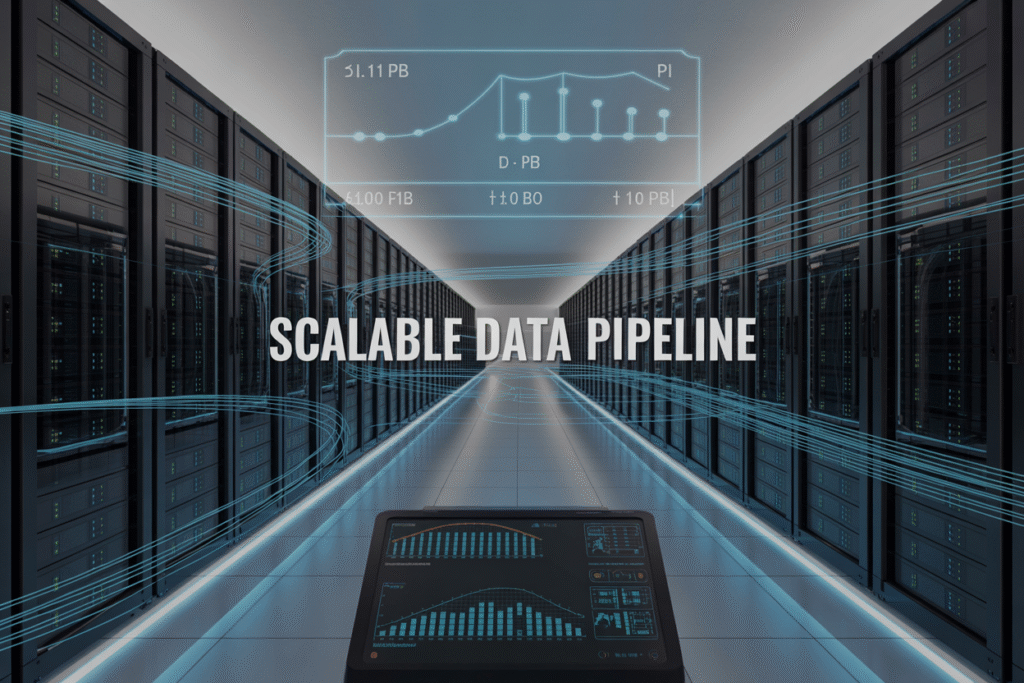Building a data pipeline that grows from gigabytes to petabytes sounds intimidating, but it’s totally doable with the right approach. This guide is for data engineers, platform architects, and tech leaders who need their data systems to handle massive growth without breaking the bank or falling over.
Most companies start small with simple data flows, then hit walls when their data explodes overnight. You’ll learn how to design your pipeline architecture for unlimited growth from day one, so you never have to rebuild from scratch. We’ll cover selecting the right data storage solutions that adapt to every scale, from your first CSV files to enterprise data lakes handling millions of records per second.
You’ll also discover how to build rock-solid data ingestion systems that keep running even when everything else goes sideways, and master the art of optimizing processing performance so your pipelines stay fast whether you’re handling gigabytes or petabytes.
Design Your Pipeline Architecture for Unlimited Growth

Choose distributed processing frameworks that handle massive data volumes
Apache Spark stands out as the go-to choice for distributed data processing across varying scales. Unlike traditional batch processing tools, Spark’s in-memory computing capabilities dramatically reduce processing times when working with large datasets. The framework automatically distributes workloads across multiple nodes, making it perfect for handling anything from gigabytes to petabytes of data.
Apache Kafka complements Spark beautifully for real-time data streaming. Kafka’s distributed architecture handles millions of events per second while maintaining fault tolerance through data replication across multiple brokers. When paired with Kafka Connect, you get seamless integration with various data sources and sinks without writing custom code.
For organizations dealing with massive batch workloads, Apache Hadoop remains relevant, especially for cost-effective storage and processing of historical data. The HDFS (Hadoop Distributed File System) provides reliable storage across commodity hardware, while MapReduce handles complex analytical tasks.
Consider Apache Flink for ultra-low latency stream processing requirements. Flink processes data as true streams rather than micro-batches, delivering millisecond-level latency that’s crucial for real-time analytics and fraud detection systems.
| Framework | Best Use Case | Latency | Scalability |
|---|---|---|---|
| Apache Spark | Batch + Stream Processing | Seconds | Excellent |
| Apache Kafka | Event Streaming | Milliseconds | Excellent |
| Apache Flink | Low-latency Streaming | Sub-millisecond | Very Good |
| Apache Hadoop | Large Batch Jobs | Minutes-Hours | Excellent |
Implement microservices architecture for independent scaling components
Breaking your data pipeline into microservices transforms how you handle scaling challenges. Each service manages a specific function—data ingestion, transformation, validation, or storage—and scales independently based on its workload demands.
Design stateless services wherever possible. Stateless microservices restart quickly, distribute easily across multiple instances, and recover from failures without data loss. Store state information in external databases or caches like Redis rather than within the service itself.
Container orchestration platforms like Kubernetes excel at managing microservices deployments. Kubernetes automatically scales services up or down based on CPU, memory, or custom metrics. When your data ingestion service experiences heavy load, Kubernetes spins up additional instances without affecting other pipeline components.
API gateways serve as traffic controllers for your microservices ecosystem. They handle authentication, rate limiting, and request routing while providing visibility into service performance. Popular choices include Kong, Istio, and AWS API Gateway.
Event-driven architecture connects your microservices effectively. Services communicate through message queues or event streams rather than direct API calls. This approach reduces coupling between services and improves overall system resilience.
Key microservices patterns for data pipelines:
- Data Ingestion Service: Handles data collection from multiple sources
- Transformation Service: Applies business logic and data cleaning
- Validation Service: Ensures data quality and schema compliance
- Storage Service: Manages data persistence across different storage systems
- Monitoring Service: Tracks pipeline health and performance metrics
Select cloud-native solutions that auto-scale based on demand
Cloud platforms provide managed services that eliminate infrastructure management headaches while delivering automatic scaling capabilities. These solutions adjust resources dynamically based on actual usage patterns rather than requiring manual capacity planning.
AWS offers several pipeline-friendly services that scale seamlessly. Amazon Kinesis handles real-time data streams with automatic sharding based on throughput demands. AWS Glue provides serverless ETL capabilities that scale from small jobs to petabyte-scale transformations. Amazon EMR launches Hadoop and Spark clusters on-demand, spinning up hundreds of nodes when needed and terminating them when jobs complete.
Google Cloud Platform excels with BigQuery for analytics workloads and Dataflow for stream and batch processing. BigQuery automatically scales compute resources based on query complexity, while Dataflow adjusts worker instances based on processing backlogs.
Azure Data Factory orchestrates complex data workflows with automatic scaling built into its execution engine. Azure Stream Analytics processes millions of events per second with automatic scaling based on input event rates.
Serverless computing takes auto-scaling to the next level. AWS Lambda, Google Cloud Functions, and Azure Functions execute code in response to data events without managing servers. These services scale from zero to thousands of concurrent executions within seconds.
Cost-effective scaling strategies:
- Use spot instances for batch processing workloads (up to 90% cost savings)
- Implement auto-scaling policies based on queue depth and processing lag
- Schedule resource scaling during off-peak hours for predictable workloads
- Monitor scaling metrics to fine-tune thresholds and avoid over-provisioning
Container services like AWS Fargate and Google Cloud Run provide the middle ground between traditional VMs and serverless functions. They offer more control than serverless while maintaining automatic scaling and pay-per-use pricing models.
Select the Right Data Storage Solutions for Every Scale

Implement data lakes for flexible petabyte-scale storage
Data lakes represent your best bet for handling massive data volumes without breaking the bank or your architecture. Unlike traditional databases that force you to define schemas upfront, data lakes let you dump raw data in any format – structured, semi-structured, or unstructured – and figure out what to do with it later.
Amazon S3, Azure Data Lake Storage, and Google Cloud Storage all provide virtually unlimited scalability. They automatically handle the complexity of distributing your data across thousands of servers while maintaining high availability. The secret sauce lies in object storage architecture, which treats each file as an independent object with its own metadata, making it incredibly efficient for large-scale operations.
When building your data lake, organize data using a hierarchical folder structure based on ingestion date, data source, and data type. This approach enables efficient querying and reduces costs when you need to access specific subsets of data. Implement data partitioning strategies early – partition by year, month, and day to avoid scanning entire datasets for time-based queries.
Choose file formats wisely. Parquet and Delta Lake formats offer superior compression and query performance compared to CSV or JSON. They also support schema evolution, which becomes critical as your data requirements change over time.
Choose distributed databases that partition data automatically
Traditional single-server databases hit a wall around the terabyte scale, but distributed databases like Cassandra, MongoDB Atlas, and Amazon DynamoDB automatically spread your data across multiple nodes without requiring manual intervention.
Auto-sharding capabilities handle the heavy lifting of data distribution. These systems monitor data growth patterns and automatically split large partitions when they exceed predefined thresholds. Cassandra, for example, uses consistent hashing to distribute data evenly across cluster nodes, while MongoDB’s sharded clusters can automatically balance data based on shard key ranges.
Consider your access patterns when selecting partition keys. Hash-based partitioning works great for random access patterns, while range-based partitioning excels when you frequently query data within specific ranges. Many modern systems offer composite sharding strategies that combine both approaches.
Replication factors become crucial at scale. Set up multiple replicas across different availability zones to ensure data durability and read performance. Most distributed databases let you configure replication per table or collection, allowing you to balance performance needs against storage costs.
| Database Type | Best Use Case | Partition Strategy | Scale Limit |
|---|---|---|---|
| Cassandra | Time-series data | Hash + Range | Hundreds of TB |
| MongoDB | Document storage | Hash or Range | Petabytes |
| DynamoDB | Key-value access | Hash | Unlimited |
| BigQuery | Analytics | Column-based | Petabytes |
Optimize storage costs with intelligent data tiering strategies
Smart data tiering can slash your storage costs by 60-80% without sacrificing accessibility. The key insight is that data access patterns follow predictable lifecycles – hot data gets accessed frequently for the first few months, then gradually cools down.
Implement automated lifecycle policies that move data through different storage tiers based on age and access frequency. Start with hot storage for frequently accessed data, transition to warm storage after 30-90 days, and finally archive to cold storage for long-term retention. Cloud providers offer seamless transitions between tiers without requiring application changes.
Amazon S3 Intelligent-Tiering automatically monitors access patterns and moves objects between access tiers, while Azure Cool and Archive tiers provide cost-effective options for infrequently accessed data. Google Cloud’s Nearline and Coldline storage classes offer similar functionality with different pricing models.
Compression strategies compound your savings. Enable compression at the storage layer – modern algorithms like LZ4 or Zstandard provide excellent compression ratios with minimal CPU overhead. Some databases offer transparent compression that automatically compresses data blocks without impacting query performance.
Data deduplication eliminates redundant copies of identical data blocks. This becomes especially valuable in backup scenarios or when dealing with versioned data. Many enterprise storage systems include built-in deduplication that can reduce storage requirements by 50% or more.
Design backup and recovery systems that scale with your data
Backup strategies that work for gigabytes crumble under petabyte loads. Traditional full backups become impractical when they take weeks to complete and consume enormous bandwidth. Instead, implement incremental and differential backup strategies that only capture changes since the last backup.
Snapshot-based backups offer near-instantaneous backup creation for supported storage systems. Cloud providers like AWS EBS snapshots and Azure disk snapshots create point-in-time copies without impacting performance. These snapshots use copy-on-write technology, so they only consume additional storage for changed blocks.
Cross-region replication provides disaster recovery capabilities while distributing backup load. Configure asynchronous replication to secondary regions, accepting slight data lag in exchange for reduced performance impact on primary systems. Most cloud databases offer built-in cross-region replication with configurable consistency levels.
Recovery time objectives (RTO) and recovery point objectives (RPO) drive your backup architecture decisions. For critical systems requiring sub-hour recovery times, maintain hot standby systems with real-time replication. For less critical data, daily backups with longer recovery windows provide acceptable protection at lower costs.
Test your recovery procedures regularly at scale. Many backup systems work fine for small datasets but fail when restoring terabytes of data. Schedule quarterly disaster recovery drills that include full-scale data restoration to validate your backup strategies actually work under pressure.
Consider backup retention policies carefully. Legal requirements might mandate keeping certain data for years, while other data can be purged after months. Implement automated retention policies that delete old backups while preserving long-term archives in the most cost-effective storage tiers.
Build Robust Data Ingestion Systems That Never Break

Deploy streaming platforms for real-time data processing
Apache Kafka stands as the gold standard for streaming data platforms, handling millions of messages per second while maintaining low latency. Set up Kafka clusters with proper partitioning strategies – partition your topics based on data characteristics and expected throughput. A well-configured Kafka cluster can process terabytes of data daily without breaking a sweat.
Amazon Kinesis offers a managed alternative that scales automatically with your data volume. Create multiple data streams for different data types, and configure shard counts based on your ingestion rate. Each shard handles up to 1,000 records per second, so plan your sharding strategy carefully.
Apache Pulsar provides another excellent option with built-in multi-tenancy and geo-replication. Its architecture separates serving and storage layers, making it incredibly resilient to failures. Set up producer and consumer configurations with appropriate batching settings to maximize throughput.
Stream processing frameworks like Apache Storm, Apache Flink, or Kafka Streams transform your raw data as it flows through the pipeline. These tools handle windowing operations, aggregations, and complex event processing without requiring data to hit disk first.
Create fault-tolerant batch processing workflows
Apache Airflow orchestrates complex batch workflows with dependencies, retries, and monitoring built right in. Design your DAGs (Directed Acyclic Graphs) with clear task dependencies and appropriate retry policies. Each task should be idempotent – running it multiple times produces the same result.
Apache Spark excels at processing large batch jobs across distributed clusters. Configure Spark jobs with dynamic resource allocation to handle varying data volumes efficiently. Use checkpointing for long-running jobs to recover from failures without starting over completely.
Implement circuit breaker patterns in your batch jobs. When downstream systems become unavailable, your pipeline should gracefully degrade rather than crash entirely. Tools like Hystrix or custom circuit breakers prevent cascading failures.
Design your batch jobs to handle partial failures gracefully. Split large datasets into smaller, manageable chunks that can be processed independently. If one chunk fails, the others continue processing normally.
Implement data validation and quality checks at ingestion points
Schema validation prevents malformed data from entering your pipeline. Use tools like Apache Avro or JSON Schema to define strict data contracts. Reject records that don’t match your expected schema immediately at ingestion time.
Data profiling tools like Great Expectations or Apache Griffin continuously monitor data quality metrics. Set up automated checks for null values, data types, value ranges, and business rule compliance. These tools generate detailed reports when data quality issues arise.
Create multiple validation layers throughout your ingestion process. First-level checks validate basic format and structure. Second-level checks verify business logic and referential integrity. Third-level checks perform statistical analysis to detect anomalies.
Implement sampling strategies for large datasets where validating every record becomes expensive. Random sampling with configurable sample rates gives you confidence in data quality without overwhelming your validation systems.
Design retry mechanisms and dead letter queues for failed data
Exponential backoff prevents overwhelming downstream systems during failures. Start with short retry intervals and gradually increase the delay between attempts. This approach gives temporary issues time to resolve while avoiding system overload.
Dead letter queues capture messages that fail processing after exhausting retry attempts. Configure separate queues for different failure types – schema validation failures, processing timeouts, and downstream service unavailability each require different handling strategies.
Implement different retry policies based on error types. Transient network errors deserve aggressive retry attempts, while schema validation errors should fail fast and move to dead letter queues immediately.
Set up monitoring and alerting for dead letter queue depths. When queues start filling up, your team needs immediate notification to investigate and resolve underlying issues. Configure automated scaling for processing dead letter queue messages during recovery periods.
Build replay capabilities to reprocess messages from dead letter queues once issues are resolved. Your pipeline should handle duplicate messages gracefully using deduplication strategies based on message IDs or business keys.
Optimize Processing Performance Across All Data Volumes

Leverage parallel processing to distribute computational workload
Breaking down data processing into smaller, simultaneous tasks transforms pipeline performance dramatically. Modern frameworks like Apache Spark, Dask, and Ray excel at splitting large datasets across multiple cores or machines, turning what would be hours-long sequential operations into minutes of parallel work.
The key lies in understanding your data’s natural partitioning boundaries. Time-based data works well when split by date ranges, while user-generated content can be distributed by user ID or geographic region. Each partition should be roughly equal in size to prevent bottlenecks where one worker finishes while others still struggle with oversized chunks.
Effective parallel processing strategies:
- Map-reduce patterns: Break complex transformations into map (transform each record) and reduce (aggregate results) operations
- Pipeline parallelism: Process different stages simultaneously rather than waiting for complete batches
- Data parallelism: Split identical operations across multiple data subsets
- Resource pooling: Share compute resources across multiple pipeline stages to maximize hardware usage
Container orchestration platforms like Kubernetes make scaling parallel workers automatic. When data volume spikes, new processing nodes spin up within minutes. When loads decrease, resources scale down to control costs.
Implement caching strategies that reduce processing time
Smart caching eliminates redundant computations and dramatically speeds up pipeline execution. The trick is identifying which intermediate results get reused frequently and storing them in fast-access locations.
Multi-layer caching works best for data pipelines. In-memory caches like Redis handle frequently accessed small datasets, while distributed file systems cache larger intermediate results. Database query result caching prevents expensive aggregations from running repeatedly.
Strategic caching approaches:
| Cache Type | Best For | Typical Storage | TTL Strategy |
|---|---|---|---|
| In-memory | Hot data, real-time queries | RAM | Minutes to hours |
| Disk-based | Intermediate results | SSD | Hours to days |
| Database | Aggregated metrics | Optimized DB | Days to weeks |
| CDN | Static reports | Global edge | Weeks to months |
Cache invalidation becomes critical as data volumes grow. Implement smart tagging systems that automatically expire cached results when source data changes. For time-series data, use sliding window caches that automatically rotate old data out while keeping recent results warm.
Consider cache warming strategies where background processes pre-compute likely queries before users request them. This works especially well for scheduled reports and dashboard updates.
Use columnar storage formats for faster query performance
Columnar storage formats like Parquet, ORC, and Delta Lake revolutionize query performance by organizing data the way analytics workloads actually access it. Instead of reading entire rows, queries scan only the columns they need, reducing I/O by 80-90% in typical scenarios.
These formats include built-in compression and encoding optimizations. Dictionary encoding handles repeated string values efficiently, while run-length encoding compresses sequences of identical values. Bloom filters and column statistics let query engines skip entire file blocks that don’t contain relevant data.
Columnar format performance benefits:
- Selective column reading: Analytics queries typically need 10-20% of available columns
- Superior compression: Homogeneous column data compresses 3-10x better than row-based formats
- Predicate pushdown: Query filters execute at the storage layer, not in memory
- Vectorized processing: Modern CPUs process columnar data much faster using SIMD instructions
Schema evolution support in formats like Delta Lake and Iceberg prevents pipeline breaks when data structures change. You can add new columns, modify existing ones, or even reorganize partition schemes without reprocessing historical data.
For maximum performance, align your partitioning strategy with common query patterns. Time-based queries benefit from date-based partitioning, while user analytics might partition by user segments or geographic regions. Proper partitioning combined with columnar storage can accelerate queries by orders of magnitude compared to traditional row-based approaches.
Monitor and Maintain Pipeline Health at Enterprise Scale

Set up comprehensive logging and alerting systems
Building a rock-solid logging infrastructure starts with collecting the right data from every component of your pipeline. You want to capture everything – from basic application logs to detailed performance metrics, error traces, and user activity. The key is structured logging using formats like JSON, which makes searching and analyzing logs much easier down the road.
Your logging strategy should follow the three-pillar approach: logs, metrics, and traces. Logs give you detailed event information, metrics provide quantitative data about system performance, and traces help you follow requests across distributed systems. Tools like ELK Stack (Elasticsearch, Logstash, Kibana), Fluentd, or cloud-native solutions like AWS CloudWatch and Google Cloud Logging can handle massive log volumes efficiently.
Smart alerting prevents small issues from becoming major outages. Create alerts that actually matter – nobody wants to wake up at 3 AM for a false alarm. Set up tiered alerting levels: warnings for potential issues, critical alerts for immediate action needed, and informational alerts for tracking trends. Use alert fatigue prevention by implementing proper thresholds, alert grouping, and automatic resolution notifications.
Track performance metrics and resource utilization continuously
Continuous monitoring gives you the visibility needed to spot problems before they impact users. Focus on four key metric categories: throughput metrics (records processed per second), latency metrics (end-to-end processing time), error rates (failed vs successful operations), and resource utilization (CPU, memory, disk, network).
Create dashboards that show both real-time and historical trends. Real-time dashboards help with immediate troubleshooting, while historical views reveal patterns and help with capacity planning. Tools like Grafana, Datadog, or Prometheus can visualize these metrics beautifully and provide drill-down capabilities when something looks off.
Don’t forget about business metrics alongside technical ones. Track data freshness, completeness, and accuracy. Monitor how long it takes for new data to become available to end users. These business-level metrics often matter more to stakeholders than pure technical performance indicators.
Implement automated testing for data quality and pipeline reliability
Automated testing acts as your safety net, catching issues before they reach production. Data quality tests should validate schema compliance, check for null values where they shouldn’t exist, verify data ranges and formats, and ensure referential integrity. Build these checks into your pipeline so they run automatically with every data batch.
Pipeline reliability testing goes beyond data quality. Test your error handling by intentionally introducing failures – what happens when a database goes down, network connections timeout, or processing nodes crash? This chaos engineering approach helps you build truly resilient systems.
Create different test environments that mirror production as closely as possible. Run smoke tests after deployments, regression tests on a schedule, and load tests before major changes. Automated testing frameworks like Great Expectations for data quality or custom testing scripts integrated into your CI/CD pipeline make this process seamless.
Plan capacity scaling based on predictive analytics
Smart capacity planning means staying ahead of demand rather than reacting to problems. Analyze historical usage patterns to predict future resource needs. Look for seasonal trends, growth patterns, and sudden spikes that might indicate special events or marketing campaigns.
Build predictive models using your monitoring data to forecast when you’ll need to scale up resources. Machine learning algorithms can identify complex patterns that simple threshold-based rules might miss. These models can predict not just when to scale, but by how much, helping optimize costs while maintaining performance.
Create automated scaling policies based on these predictions. Your system should be able to spin up additional processing power before peak loads hit and scale down during quiet periods. This proactive approach prevents performance degradation and keeps costs under control. Cloud platforms make this easier with auto-scaling groups and serverless technologies that adjust resources automatically.
Consider different scaling scenarios in your planning. What if data volume doubles overnight? What if a critical component fails during peak processing time? Having runbooks and automated responses for these situations keeps your pipeline running smoothly even when unexpected events occur.
Manage Costs While Scaling Your Data Infrastructure

Optimize compute resources with auto-scaling policies
Smart auto-scaling keeps your data pipeline running efficiently without burning through your budget. Set up scaling rules based on actual workload patterns rather than peak capacity estimates. Configure horizontal scaling for distributed processing jobs and vertical scaling for memory-intensive operations.
Most cloud platforms offer predictive scaling that analyzes historical usage patterns to pre-provision resources before demand spikes. This prevents performance bottlenecks while avoiding the costs of over-provisioning. Set conservative scaling thresholds initially – you can always adjust them as you gather more data about your pipeline’s behavior.
Consider using spot instances for batch processing jobs that can tolerate interruptions. These instances cost up to 90% less than on-demand pricing and work perfectly for non-critical data transformations. Implement checkpointing in your processing logic so jobs can resume from where they left off if a spot instance gets reclaimed.
Container orchestration platforms like Kubernetes provide sophisticated resource management capabilities. Use resource limits and requests to prevent any single job from consuming excessive resources, and implement quality of service classes to prioritize critical workloads during resource contention.
Implement data lifecycle management to reduce storage costs
Data doesn’t need to live in expensive hot storage forever. Create tiered storage policies that automatically move older data to cheaper storage classes based on access patterns and business requirements. Most organizations find that 80% of their data becomes cold within 30-90 days.
Archive infrequently accessed data to glacier storage tiers, which can cost as little as $0.004 per GB per month compared to $0.023 for standard storage. Set up automated policies that transition data through storage classes: hot storage for recent data, warm storage for monthly reports, and cold storage for compliance archives.
Implement data compression and deduplication strategies to reduce storage footprints. Modern compression algorithms can reduce storage requirements by 60-80% for typical business data. Use column-oriented formats like Parquet for analytics workloads – they provide excellent compression ratios while maintaining query performance.
Delete unnecessary data aggressively. Many pipelines accumulate temporary files, failed job outputs, and duplicate datasets that serve no purpose. Regular cleanup jobs can free up significant storage capacity. Create retention policies for logs, intermediate processing results, and backup files.
Choose cost-effective cloud pricing models for your usage patterns
Reserved instances can save 30-70% on compute costs when you have predictable baseline workloads. Analyze your usage patterns over several months to identify steady-state resource requirements, then purchase reserved capacity for those workloads while using on-demand instances for variable loads.
Committed use discounts work well for data storage and bandwidth charges. These programs offer significant discounts in exchange for committing to specific usage levels over 1-3 year terms. Start with conservative commitments and increase them as your pipeline matures and usage patterns stabilize.
Multi-region deployments might seem expensive initially, but they can reduce data transfer costs significantly. Placing processing resources closer to data sources eliminates expensive cross-region bandwidth charges. A pipeline processing 100TB monthly across regions could save thousands in transfer fees by optimizing data locality.
Explore alternative cloud providers and hybrid approaches for specific workloads. While major cloud providers offer comprehensive services, specialized providers often deliver better price-performance ratios for specific use cases like long-term archival storage or high-performance computing workloads.
Monitor your spending with detailed cost allocation tags and automated budget alerts. Set up cost anomaly detection to catch unexpected charges early. Many organizations discover they’re paying for unused resources or inefficient configurations that can be optimized with proper monitoring.

Building a data pipeline that grows with your business isn’t just about picking the right tools—it’s about smart planning from day one. When you design your architecture with scalability in mind, choose storage solutions that match your current and future needs, and build ingestion systems that can handle anything thrown at them, you’re setting yourself up for success. The key is balancing performance optimization with cost management while keeping a close eye on your pipeline’s health through proper monitoring.
Don’t wait until you hit a wall to start thinking about scale. Start implementing these practices today, even if you’re only dealing with gigabytes of data. Your future self will thank you when your pipeline effortlessly handles that first petabyte milestone. Remember, the best data pipelines are the ones that grow invisibly alongside your business, never becoming the bottleneck that slows down your team’s ability to make data-driven decisions.
